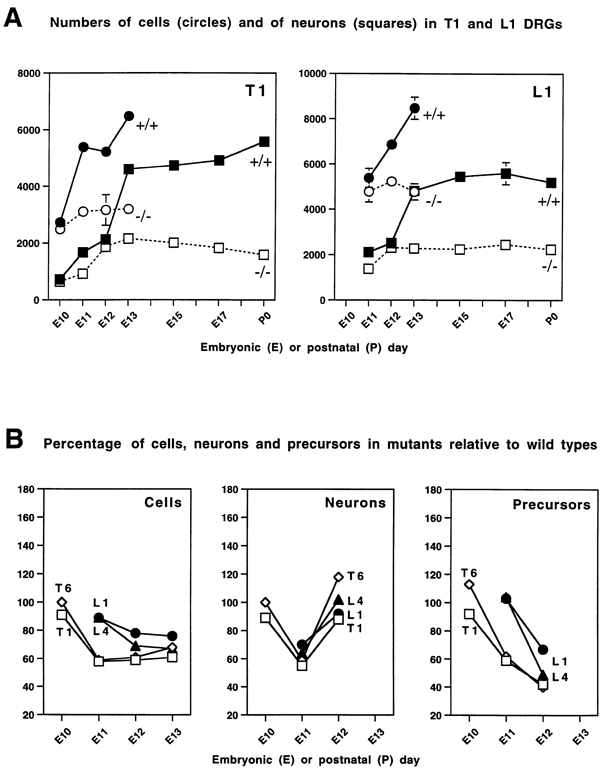Figure 2.
Graphical Representations of Numbers of Cells, Neurons, and Precursors in Normal and Mutant DRGs
(A) Quantitation of the number of total cells and neurons at different embryonic (E) and postnatal (P) stages in thoracic 1 (T1) and lumbar 1 (L1) DRGs in wild types and NT-3 mutants. Total number of cells (circles) and of neurons (squares) in wild-type (filled symbols, continuous line) and mutant (empty symbols, dotted line) ganglia. Numerical data used to construct these graphs is presented in Tables 1 and 2. Since the normal development and phenotype of the mutation are similar in all ganglia analyzed, the data for only two of the four ganglia are presented graphically here. At E10 there are no differences between wild-type and mutant embryos in the number of cells or neurons, as seen in the T1 DRG (lumbar ganglia are not well defined at this stage). At E13, the final number of neurons in normal embryos and the complete deficit found in mutant embryos at birth are achieved in both T1 and L1 DRGs. Note that the number of neurons is significantly reduced in mutant ganglia at E11 (see Table 1 for statistical significance), but that between E11 and E12 higher than normal neurogenesis in the mutant eliminates the deficits in total neuronal numbers by E12. Between E12 and E13, the number of neurons increases very rapidly in wild-type but not in mutant animals. (B) Relative percentages of cells, neurons, and precursors (total number of cells minus number of neurofilament positive cells) present in mutant compared with wild-type ganglia from E10 to E13. Data from the four different ganglia analyzed are plotted: T1 (squares), T6 (diamonds), L1 (circles), and L4 (triangles). There is an initial significant (see Table 1) deficit in the number of neurons in all ganglia at E11 that is compensated at E12. In lumbar ganglia, a deficit in neurons is not accompanied by a deficit in precursors. Notice also that the increased numbers of neurons appearing in mutant ganglia between E11 and E12 is accompanied by equally dramatic reductions in the numbers of precursors, suggesting that neurogenesis may be accelerated in the absence of NT-3.

